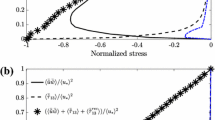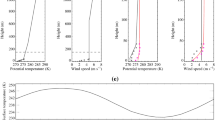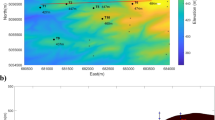Abstract
With probably no exception, in atmospheric numerical models, a high vertical resolution is used close to the surface, with gradually reduced resolution higher up. This seems an obvious choice given the importance and complexity of processes close to the ground, and the cost of using a high near-surface resolution throughout the model atmosphere. But there are disadvantages involved that deserve attention. One is that the performance of numerical schemes is generally better for uniform resolution, in particular when the finite-volume approach is used. Another is that with the usual terrain-following vertical coordinate, horizontal flow across high topography will be subject to severe resolution changes encountering the topography. An unintended experiment of the impact of these disadvantages is a by-product of the so-called “parallel” run of two models at the U.S. National Centers for Environmental Prediction in 2006, when the operational Eta model was compared against its intended replacement, the NMM model. In that four+ month experiment the Eta model more accurately forecast 10-m wind speed and 2-m temperatures over the mostly high topography of the western United States than the NMM, despite its much poorer vertical resolution over that area and not too different physical parametrizations. It is suggested that the severe NMM grid cell resolution change of horizontal flow encountering high topography with terrain-following coordinates is the main cause of this result.



Similar content being viewed by others
Data availability
The datasets analysed during the current study are available in the publicly available reference DiMego (2006).
References
Arthur RS, Lundquist KA, Wiersema DJ, Bao J, Chow FK (2020) Evaluating implementations of the immersed boundary method in the Weather Research and Forecasting model. Mon Weather Rev 148:2087–2109
Blackadar AK (1962) The vertical distribution of wind and turbulent exchange in a neutral atmosphere. J Geophys Res 67:3095–3102
Bougeault P (1997) Physical parametrizations for limited area models: some current problems and issues. Meteorol Atmos Phys 63:71–88
Chen F, Zhang Y (2009) On the coupling strength between the land surface and the atmosphere: From viewpoint of surface exchange coefficients. Geophys Res Lett 36:L10404. https://doi.org/10.1029/2009GL037980
Chen F, Janjic Z, Mitchell K (1997) Impact of atmospheric surface-layer parameterization in the new land-surface scheme of the NCEP mesoscale Eta model. Boundary-Layer Meteorol 85:391–421
Chow FK, Schär C, Ban N, Lundquist KA, Schlemmer L, Shi X (2019) Crossing multiple gray zones in the transition from mesoscale to microscale simulation over complex terrain. Atmosphere 10(5):274. https://doi.org/10.3390/atmos10050274
DiMego G (2006) WRF-NMM & GSI Analysis to replace Eta Model & 3DVar in NAM Decision Brief. National Centers for Environmental Prediction, 115 pp. https://www.yumpu.com/en/document/view/29953548/nam-wrf-noaa-national-operational-model-archive-
Durran DR (2010) Numerical methods for fluid dynamics with applications to geophysics, 2nd edn. Springer, Berlin
Galperin B, Kantha LH, Hassid S, Rosati A (1988) A quasi-equilibrium turbulent energy model for geophysical flows. J Atmos Sci 45:55–62
Georgelin M, Richard E, Petitdidier M, Druilhet A (1994) Impact of subgrid-scale orography parameterization on the simulation of orographic flows. Mon Weather Rev 122:1509–1522
Janjić ZI (1984) Nonlinear advection schemes and energy cascade on semi-staggered grids. Mon Weather Rev 112:1234–1245
Janjić ZI (1990) The step-mountain coordinate: Physical package. Mon Weather Rev 118:1429–1443
Janjić ZI (1994) The step-mountain eta coordinate model: Further developments of the convection, viscous sublayer, and turbulence closure schemes. Mon Weather Rev 122:927–945
Janjic ZI (1996) The surface layer in the NCEP Eta Model. In: Proceedings of the 11th conference on numerical weather prediction, 19–23 August 1996, Norfolk, VA, 354–355
Kleist DT, Parrish DF, Derber JC, Treadon R, Wu W-S, Lord S (2009) Introduction of the GSI into the NCEP global data assimilation system. Wea Forecasting 24:1691–1705
Mahrt L (1996) The bulk aerodynamic formulation over heterogeneous surfaces. Boundary-Layer Meteorol 78:87–119
Mahrt L (1999) Stratified atmospheric boundary layers. Boundary-Layer Meteorol 90:375–396
Mahrt L, Sun J, MacPherson JI, Jensen NO, Desjardins RL (1997) Formulation of surface heat flux: application to BOREAS. J Geophys Res 102(D24):29,621-29,649
Mason PJ (1986) On parametrization of orographic drag. Seminar physical parametrization for numerical models of the atmosphere. ECMWF Reading U.K., pp 139–165
Mellor GL, Yamada T (1974) A hierarchy of turbulence closure models for planetary boundary layers. J Atmos Sci 31:1791–1806
Mellor GL, Yamada T (1982) Development of a turbulence closure model for geophysical fluid problems. Rev Geophys Space Phys 20:851–875
Mesinger F (1993a) Forecasting upper tropospheric turbulence within the framework of the Mellor-Yamada 2.5 closure. Res Act Atmos Ocean Model WMO, Geneva, CAS/JSC WGNE Rep vol 18, pp 4.28–4.29
Mesinger F (1993b) Sensitivity of the definition of a cold front to the parameterization of turbulent fluxes in the NMC's Eta model. Res Act Atmos Ocean Model, WMO, Geneva, CAS/JSC WGNE Rep vol 18, pp 4.36–4.38
Mesinger F (2010) Several PBL parameterization lessons arrived at running an NWP model. In: International conference on planetary boundary layer and climate change. IOP Publishing, IOP Conference Series: Earth and Environmental Science 13. https://doi.org/10.1088/1755-1315/13/1/012005
Mesinger F, Lobocki L (1991) Sensitivity to the parameterization of surface fluxes in NMC's Eta model. Preprints, Ninth Conference on Numerical Weather Prediction, Denver, CO, 14–18 October 1991; American Meteorological Society, Boston, MA, pp 213–216
Mesinger F, Veljovic K (2017) Eta vs. sigma: Review of past results, Gallus-Klemp test, and large-scale wind skill in ensemble experiments. Meteorol Atmos Phys 129:573–593
Mesinger F, Veljovic K (2020) Topography in weather and climate models: Lessons from cut-cell Eta vs. European Centre for Medium-Range Weather Forecasts experiments. J Meteorol Soc Japan 98:881–900. https://doi.org/10.2151/jmsj.2020-050
Mesinger F, Wobus RL, Baldwin ME (1996) Parameterization of form drag in the Eta model at the National Centers for Environmental Prediction. Preprints, Eleventh Conference on Numerical Weather Prediction, Norfolk, VA, 19–23 August 1996; American Meteorological Society, Boston, MA, pp 324–326
Mesinger F, DiMego G, Kalnay E, Mitchell K, Shafran PC, Ebisuzaki W, Jovic D, Woollen J, Rogers E, Berbery EH, Ek MB, Fan Y, Grumbine R, Higgins W, Li H, Lin Y, Manikin G, Parrish D, Shi W (2006) North American regional reanalysis. Bull Am Meteorol Soc 87:343–360
Mesinger F, Chou SC, Gomes J, Jovic D, Bastos P, Bustamante JF, Lazic L, Lyra AA, Morelli S, Ristic I, Veljovic K (2012) An upgraded version of the Eta model. Meteorol Atmos Phys 116:63–79
Mesinger F, Rančić M, Purser RJ (2018) Numerical methods in atmospheric models. In: Oxford research encyclopedia of climate science. https://doi.org/10.1093/acrefore/9780190228620.013.617
Sun J, Massman W, Grantz DA (1999) Aerodynamic variables in the bulk formulation of turbulent fluxes. Boundary-Layer Meteorol 91:109–125
Thuburn J (2011) Vertical discretization: some basic ideas. In: Lauritzen PH, Jablonowski C, Taylor MA, Nair RD (eds) Numerical techniques for global atmospheric models. Springer, Berlin, pp 59–74
Zilitinkevich SS (1995) Non-local turbulent transport: Pollution dispersion aspects of coherent structure of convective flows. In: Power H, Moussiopoulos N, Brebbia CA (eds) Air Pollution III—Volume I: air pollution theory and simulation. Computational Mechanics Publications, Southampton Boston, pp 53–60
Acknowledgements
It is a pleasure to acknowledge assistance of Drs. Eric Rogers, Michael Ek, and Matthew Pyle, of NCEP/EMC, and Fei Chen, of the National Center for Atmospheric Research, Boulder, Colorado, in efforts to recall specifics of the NCEP 2006 parallel test. Prof. Larry Mahrt, of the NorthWest Research Associates, Redmond, Washington, helped with information regarding applicability of (1). Prof. Katarina Veljovic, of the Faculty of Physics of the University of Belgrade, assisted in generating Fig. 2 of this paper. Suggestions and comments of two anonymous reviewers helped improve the text of this note and are gratefully acknowledged. The late Sergej Zilitinkevich, via his untimely passing, generated the birth of this modest contribution, dedicated to the greatness of Sergej's mind, his humanity and unwavering spirit.
Author information
Authors and Affiliations
Corresponding author
Ethics declarations
Conflict of interest
The author declares to have no conflict of interest regarding statements made in this study.
Additional information
Publisher's Note
Springer Nature remains neutral with regard to jurisdictional claims in published maps and institutional affiliations.
Rights and permissions
Springer Nature or its licensor holds exclusive rights to this article under a publishing agreement with the author(s) or other rightsholder(s); author self-archiving of the accepted manuscript version of this article is solely governed by the terms of such publishing agreement and applicable law.
About this article
Cite this article
Mesinger, F. Vertical Resolution of the Surface Layer versus Finite-volume and Topography Issues. Boundary-Layer Meteorol 187, 95–104 (2023). https://doi.org/10.1007/s10546-022-00745-2
Received:
Accepted:
Published:
Issue Date:
DOI: https://doi.org/10.1007/s10546-022-00745-2




